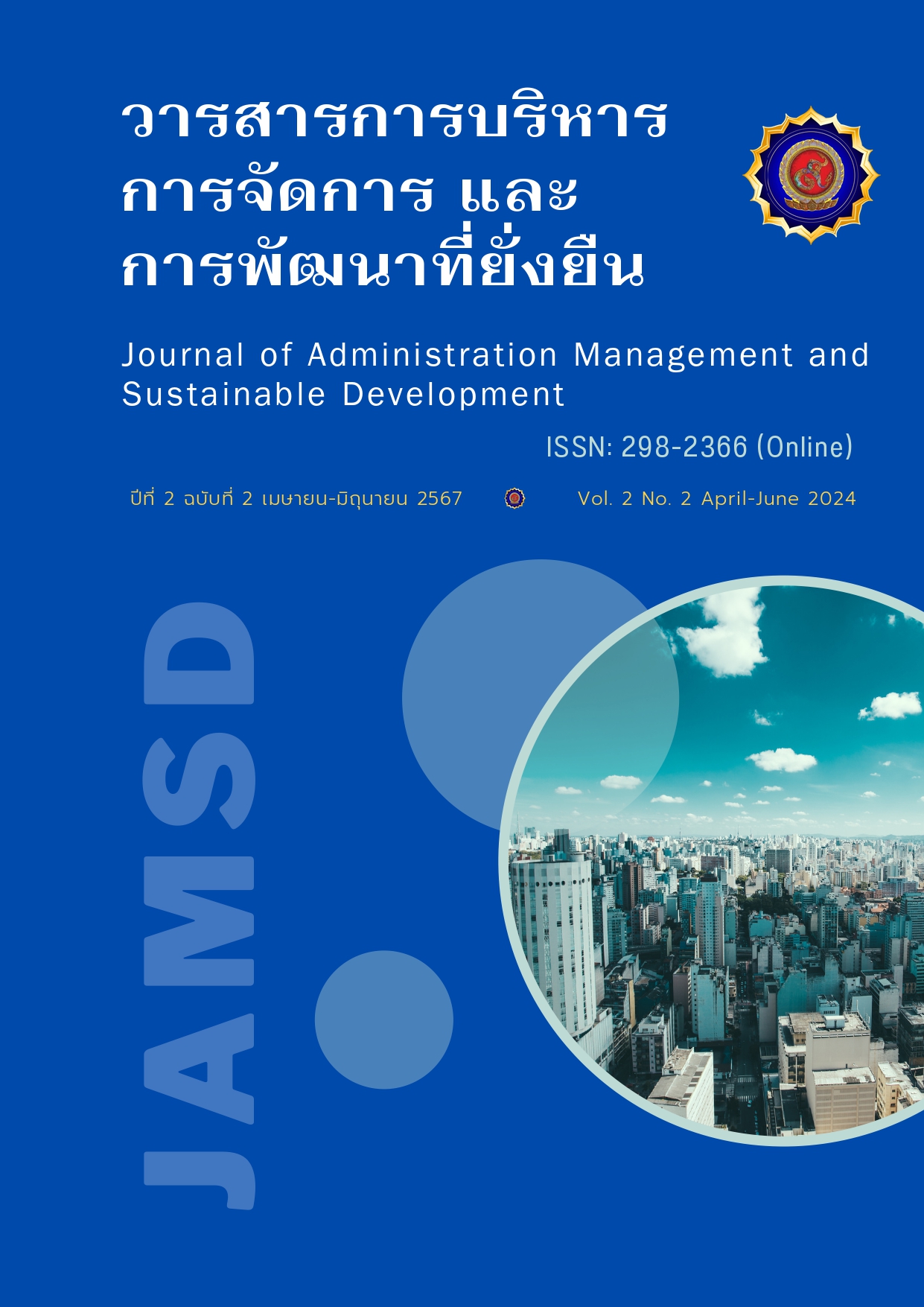Guidelines for promoting efficiency in undergraduate student services Faculty of Political Science and Public Administration Maha Sarakham Rajabhat University
Keywords:
educational services, efficiencyAbstract
This research aims to study: 1) guidelines for promoting efficiency in undergraduate student services. Faculty of Political Science and Public Administration, Maha Sarakham Rajabhat University, 2) To study recommendations for ways to promote efficiency in undergraduate student services. Faculty of Political Science and Public Administration, Maha Sarakham Rajabhat University. The researcher determined the sample size using Krejcie and Morgan's ready-made tables (Krejcie & Morgan, 1970, cited in Teerawut Ekakul, 2000), with a total of 265 people. The statistics used were frequency, mean, percentage, deviation, and standard deviation. Result founded: 1) comments on the service were at a high level when classified by aspects; it was found that the high level was on two sides; the facilities aspect was at a moderate level, totaling 3 aspects: service process, service results, and service personnel, respectively. 2) The suggestions for the development and improvement of services sorted by descending below should provide a one-stop service. Percentage 34.78, should plan the autoimmune process in the service and provide details involved in each stage. Percentage 30.43, should be prescribed period and provide each step to clear Percentage 26.08 should be served with politeness. Percentage 22.82 should be equalized and does not discriminate in providing services. Percentage 21.73, there should be a continuation of coordination between agencies to reduce latency. Percentage of 19.56, and should have sample forms to fill out documents to make it more convenient. Percentage 16.30, the serving officer should have enthusiastically or reluctantly served Percentage 13.00, should have a cabinet for review of the service, Percentage 10.86, and should have a system of notification steps, Percentage 10.86, respectively.
References
กิตติวงค์ สาสวด. (2554). การพัฒนาคุณภาพการบริการการศึกษาและประสิทธิผลการจัดการศึกษาในมหาวิทยาลัยราชภัฏเขตภูมิศาสตร์ภาคกลาง. วิทยานิพนธ์บริหารธุรกิจดุษฎีบัณฑิต มหาวิทยาลัยราชภัฏสวนสุนันทา.
คู่มือนักศึกษาประจำปี พ.ศ.2564. (2564). สารจากอธิการบดี. มหาสารคาม: มหาวิทยาลัยราชภัฏมหาสารคาม.
ธีรวุฒิ เอกะกุล. (2543). ระเบียบวิธีวิจัยทางพฤติกรรมศาสตร์และสังคมศาสตร์. (พิมพ์ครั้งที่1). อุบลราชธานี: สถาบันราชภัฎอุบลราชธานี.
นภดล เลือดนักรบ, สุภาณี เส็งศรีและ พิศิษฐ์ พลธนะ. (2560). ICT: เทคโนโลยีสารสนเทศเพื่อสนับสนุนการ เรียนรู้. วารสารวิชาการสาธารณสุข, 9(1).
นันทวุฒิ ธุระพระ. (2554). ความพึงพอใจต่อการให้บริการงานพัสดุ คณะเภสัชศาสตร์ มหาวิทยาลัยขอนแก่น. วิทยานิพนธ์ครุศาสตรมหาบัณฑิต. มหาวิทยาลัยราชภัฏเลย.
บุญชม ศรีสะอาด.(2545). การวิจัยเบื้องต้น. (พิมพ์ครั้งที่ 6). กรุงเทพฯ: สุวีริยาสาสน์.
_______. (2546). การวิจัยเบื้องต้น. (พิมพ์ครั้งที่ 7). กรุงเทพมหานคร : สุวีริยาสาสน์.
ไพรพนา ศรีเสน. (2544). ความคาดหวังของผู้รับบริการต่อคุณภาพบริการในงานผู้ป่วยนอกโรงพยาบาลศิริราช คณะแพทยศาสตร์ศิริราชพยาบาล มหาวิทยาลัยมหิดล. วิทยานิพนธ์ พัฒนาบริหารศาสตรมหาบัณฑิต สาขาพัฒนาสังคม สถาบันบัณฑติพัฒนบริหารศาสตร์.
มานิตย์ สารคำ. (2561). ประสิทธิภาพการทำงานธุรการ กองบริการการศึกษาต่อหน่วยงานภายในมหาวิทยาลัยมหาสารคาม. มหาสารคาม: กองบริการการศึกษา.
รัตนา เนื่องแก้ว. (2557). การพัฒนาระบบธุรการสถานวิทยาศาสตร์คลินิก คณะแพทยศาสตร์ มหาวิทยาลัยธรรมศาสตร์. กรุงเทพฯ: ธรรมศาสตร์เวชสาร, 14(2).
สุภาพร หาชัยภูมิ (2562). ประสิทธิภาพของการปฏิบัติหน้าที่และการให้บริการงานธุรการ สำนักงานคณบดีคณะเทคโนโลยีสารสนเทศ มหาวิทยาลัยราชภัฏมหาสารคาม. มหาวิทยาลัยราชภัฏมหาสารคาม.
Albrecht, K. (2000). Service quality by design: Principles and practices for positive customer experiences. Upper Saddle River,
Bertalanffy, L. von. (1968). General systems theory: Foundations, development, applications. New York: George Braziller.
Churchill, G. A. (1979). A paradigm for developing and evaluating measures of consumer satisfaction. Journal of Marketing Research, 16(1), 64-71.
Dessler, G. H. (2015). Human resource management. Upper Saddle River, NJ: Pearson Prentice Hall.
Parasuraman, A., Zeithaml, V. A., & Berry, L. L. (1988). SERVQUAL: A multiple-item scale for measuring service quality. Journal of Retailing, 64(1), 9-14.
Reichheld, F. F. (2001). The loyalty effect: The new science of customer loyalty. New York: Harvard Business School Press.
Zeithaml, V. A., Berry, L. L., & Parasuraman, A. (2000). Delivering quality service: Balancing customer expectations and operational realities. New York: Free Press.





